Not the only turbocharged Porsche, but the 911 Turbo remains The King
What is it?
It’s Type 991 Gen 2 with a capital T. The 2017 Turbo and Turbo S carry Porsche’s new 911 lineup to its tippy top.
August Achleitner, Porsche’s vice president for the 911 line, says the Turbo remains the “spearhead of technology” among 911s, and he’s not off the mark. Yet for 41 years the Turbo’s appeal has been more emotive or impressionistic than technical. In some circles the 911 with the big rear wing—like Elvis or a handful of pop stars known almost universally by a single name—is just the Turbo. There are cars with turbocharged engines, and there’s the Turbo.
Like the rest of the ’17 lineup the Turbo starts on the 991 platform, introduced as the 2012 911 and re-proportioned to increase interior space and move more mass forward of its rear wheels. Gen 2 is heavily revised, with a new fuel injection system, a re-engineered PDK transmission and an updated infotainment package. Yet the biggest change for Carreras and other Gen 2 variants is downsized, turbocharged engines. The Turbo is no longer the singular 911 turbo and it remains to be seen how many people care.
All ’17 911s get what Porsche calls “sharpened styling.” Elements across the line include larger grilles in the front valance, four DRL diodes fixed around the main projection headlights, reshaped mirrors, new door handles and revised engine covers. The 911 Spotter’s Guide lists subtle Turbo distinctions, nonetheless.
The center grille below the Turbo’s front bumper is larger and angled outward from top to bottom rather than inward. Its big rear fenders—the Turbo is at least an inch wider at the rear wheels than any other 911—are punched with ports to feed air through the intercoolers. There are bigger vents in the corners of the rear valance where the charge cooling air dumps. The Turbo’s engine cover has a vertical scoop, and it’s missing the thin, LED light bar connecting the taillights on other all-wheel-drive 911s. Four quadrangle exhaust trips spread wide in its rear valance, as opposed to two circular tips toward the center on the Carrera 4.
The Turbo comes with an active aerodynamic package front and rear, combining an extendable front spoiler with a slotted rear wing that changes angle and height. The objective is maintaining the balance of downforce front and rear as speed increases. Porsche claims the system trims at least two seconds from the ’17 Turbo’s Nürburgring time, compared to when it’s switched off.
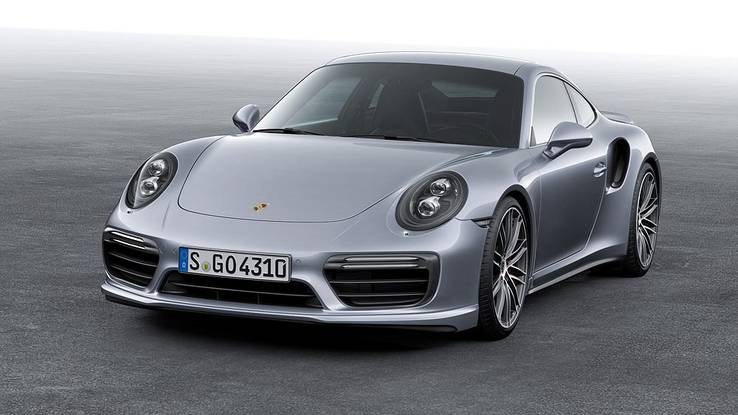
The 2017 Turbo and Turbo S are the stars of the Porsche 911 lineup.
There’s no downsizing for the Turbo engine. Where other 911s have dropped to 3.0 liters displacement, the Turbo’s horizontally-opposed six continues at 3.8. It remains the only gasoline-fueled engine with variable geometry turbochargers, though for the first time the upgrade Turbo S is fitted with its own unique turbos. They’re larger than the standard Turbo’s, and fabricated of different metals to cope with even higher temperatures.
So trimmed the Turbo six generates 540 horsepower standard and 580 in the S (up 20 in both cases), with 523 and 553 pound feet respectively (up 36). The power increase drops 0-60 mph times 0.1 second, according to Porsche, to 2.8 for S, 2.9 standard. Not slow.
Top speed increases seven to 205 mph for the S, yet fuel economy improves 6 percent in the European cycle (EPA numbers are pending), thanks to efficiencies in the transmission and the new fuel injection. This dual-pump DI increases maximum pressure from 2,000 to 2900 psi, further atomizing fuel and improving combustion efficiency.
The new Turbo engine also introduces something Porsche calls Dynamic Boost, intended to improve throttle response and eliminate even the possibility of turbo lag. When the driver releases the accelerator, the ECM cuts fuel delivery, but leaves the throttle valve open so the turbos keep spinning. Back on the gas, the injectors deliver again, without a significant reduction in boost pressure.
Porsche DoppelKupplunggetriebe—the seven-speed PDK dual-clutch automatic—gets several enhancements. Most prominent is a dual-mass flywheel with a centrifugal pendulum, intended to reduce vibration and allow the engine to run at lower rpm in higher gears. The shift pattern on the console lever has been reversed to match the GT3 and 911 race cars. Downshifts are now forward, and upshifts back.
The all-wheel drive is revised with a new water-cooled, hydraulically operated multi-clutch transfer case. It’s more rugged, to accommodate higher torque, and its friction coefficient increases to adjust front/rear torque flow in quicker, more precise increments. The Turbos come standard with a locking rear differential and torque-vectoring control strategy.
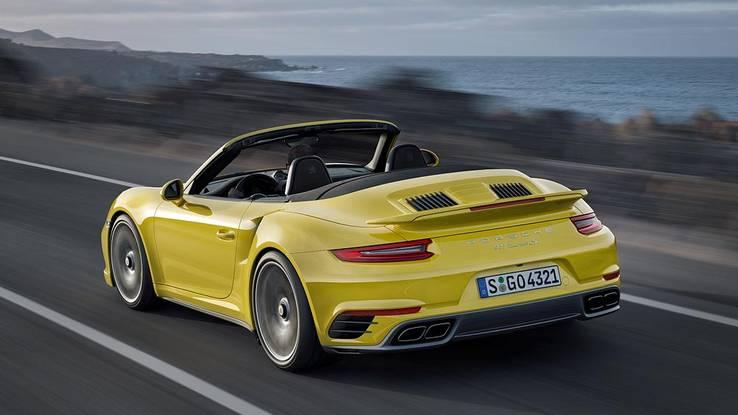
The 2017 Turbo and Turbo S are the stars of the Porsche 911 lineup.
Underneath, Porsche’s Active Suspension Management (PASM) gets a broader range of adjustment from comfort to full sport. The same applies to the stability electronics, and there’s more individual tailoring of various control systems, from drivetrain to chassis. Porsche’s rear-steer system is standard on the Turbos, while the S includes Porsche Dynamic Chassis Control (PDCC) in the base price. This hydraulically operated active roll-management system effectively stiffens or decouples the anti-roll bars for maximum roll control or comfort.
The Turbo’s standard bi-metal brake rotors are larger than before, with red calipers. The S upgrades to ceramic-composite brakes—50 percent lighter than cast-iron rotors—with yellow calipers. Both Turbos get 20-inch wheels, fitted with 245/35 ZR Pirelli P Zero N1s in front, 305/30 rear. Each model gets its own wheel design, with center locks for the S and a third, ultra-light option for both.
The Turbos aren’t just the most powerful 911s. They’re also the most heavily equipped. The 2017s come standard with Porsche’s Sport Chrono package, front and rear park assist, back-up camera, full LED headlights with adaptive control and leather dash and doors—two tone in the S. The S also adds a seat upgrade and carbon-fiber interior trim.
The 991.2 Turbos hit U.S. showrooms in April, ranging from $ 160,250 for a Turbo coupe to $ 201,450 for a Turbo S Cabriolet before options. Gen 2 Carrera 4s and Targa 4s debut at the same time, fitted with the new AWD system and the 3.0-liter Carrera engine (370 horsepower standard, 420 in S trim).
Porsche unveiled the original Turbo (Type 930) at the Paris Motor Show in 1974, motivated partly by changes in motorsport homologation requirements, smack in the midst of the first oil crunch and the worst recession since World War II. That Turbo is widely considered the first series-built sports car with exhaust turbocharging and pressure regulation. Its air-cooled, single-turbo 3.0-liter boxer delivered 260 brake horsepower and 260 lb-ft of torque. If those numbers seem puny today, it must be noted the first Turbo was also the quickest, fastest series production car then available (0-60 mph in 5.2 seconds, top speed 160). It was anything but civil, described in contemporary reviews as a handful even for expert drivers. Sales exceeded Porsche’s modest expectations, and Turbo posters proliferated on bedroom walls across America.
These ninth-gen 2017 Turbos are probably the best—certainly the fastest—ever; but given the visceral rage that planted the original Turbo in the hearts of enthusiasts everywhere, their heritage might demand more.
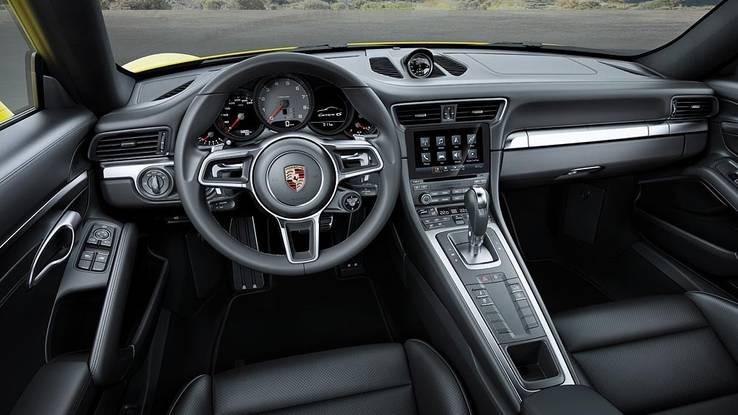
The 2017 Turbo and Turbo S are the stars of the Porsche 911 lineup.
How’s it drive?
After two laps around the refurbished Kyalami Grand Prix Circuit in South Africa and another 20 minutes slogging crowded roads around Johannesburg, it’s hard to evaluate the subtleties of a mega-performance car. Unfortunately, that’s all Porsche allowed. We can say only a few things with any authority or conviction.
The 2017 Turbos are fast—crazy, omnipotent fast. Fire off full-plant from a stop, even without launch control, and the Turbo will blow your passenger’s face off and leave him dizzy, g-load drunk to 120 and beyond, wondering exactly where his stomach fell out.
Try again with launch control and the bit of saliva left in your slightly nervous mouth will be slammed somewhere into your throat. There’s no clutch slip and little slither or tire squawk—just prodigious grip at all four wheels and raw acceleration rarely experienced in automobiles certified Grade A for class reunions in the Hamptons or profiling on the Vegas strip.
But the Turbo was already that. We doubt anyone will notice the additional 20 horsepower in the new one–maybe not even the extra 40 in the Turbo S. If the rush of acceleration is what you seek most readily, you can probably save 12 large and skip the S upgrade.
We can tell you that, if you choose to circle back to find your passenger’s stomach at a more casual pace, the Turbo immediately reverts to civil behavior. At light throttle the PDK clicks up to sixth gear by 25 mph with the engine at about 1200 rpm, and you won’t even notice thanks to the dual mass flywheel and pendulum. No chugging, chattering or lugging. Just smooth. PDK comes reasonably close to a good torque-converter automatic in overall smoothness, even as it allows the same control as and better shift speed than a conventional manual, or better, smarter, faster shifting in full-auto mode on a track. It’s nice when you’re trying to follow around a high-speed circuit like Kyalami.
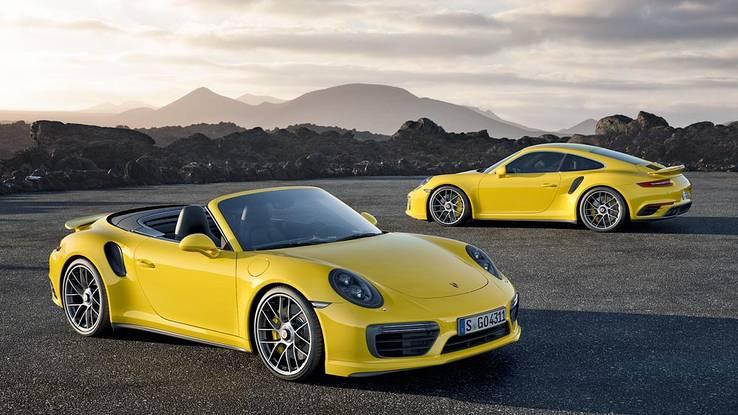
The 2017 Turbo and Turbo S are the stars of the Porsche 911 lineup.
The refurbished Grand Prix track, updated to full FIA spec, is too fast for this guy to learn in a few laps (or maybe ever), especially when there are streams running across a handful of the apexes and exits as refurbishers experiment with drainage. The hardware and software in the Turbo—huge tires, Porsche Stability Management, all-wheel grip—make it easier. With electronics at the least intrusive level before all-off, there’s enough protection to save a reasonably prudent driver from himself, and more than enough power to overcome bad lines or momentum losses. You might not be driving particularly well, but you’re still going a hell of a lot faster than a 98th-percentile driver in a Miata.
The Turbo as it’s evolved isn’t foremost a track car, anyway. It’s more the all-things-to-all-types alpha dog. Porschephiles who frequently track are probably driving something else when they get there.
We can tell you that despite some differences from the good ol’ days, the 911’s steering might be the best evolution of electric assist so far. We can tell you the ceramic brakes squeak and grate more than cast iron after hard track use.
We can’t tell you if Dynamic Boost really improves throttle response or banishes lag in a wide range of circumstances. We can’t tell you what we think of default rates in the new PASM control map, because there wasn’t enough time to pay attention.
The key take away from a short drive in a 2017 Turbo doesn’t change a whit from a 2015. As it’s been for at least the last three or four generations, as technology has allowed Porsche to manage boost more like a rheostat than an on/off toggle, the Turbo capital T remains among the ultimate bi-modal GTs on earth, regardless of price. The beast within can be subtle. It’s not at all demanding to drive to a reunion in the Hamptons. It’s amazingly flexible and comfortable. Its comportment, at least from the driver’s seat, can be as non-descript as a 580-hp sports car can be–like a good microwave oven that cooks things fast with a supremely intuitive keypad. That’s a compliment.
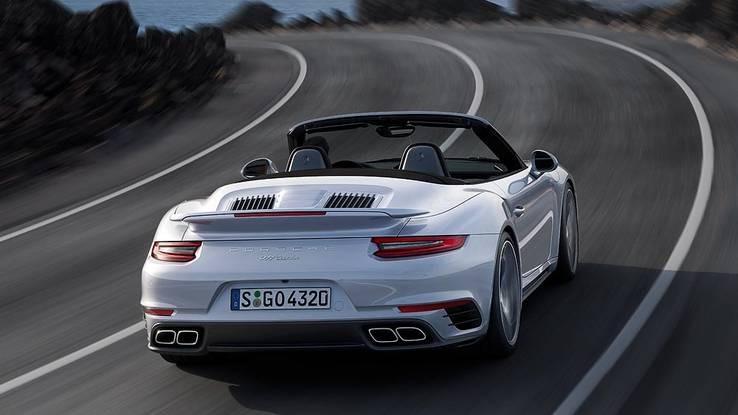
The 2017 Turbo and Turbo S are the stars of the Porsche 911 lineup.
Do I want it?
Silly question. It’s a Turbo, for crying out loud. The original.
Of course, the Turbo’s balance of civility and thrills pretty much applies to all 991.2 911s. What distinguishes the Turbo–down to sound, which is much harder to tell from the newly turbocharged Carreras–is the massive upgrade in horsepower and torque that can leave passengers looking for their stomachs. While that matters a lot–maybe most to a lot of people–it’s harder to draw a significant distinction in core character or fun quotient or, if you check the right boxes, luxury inside the Turbo. More than ever, the ultimate 911 is defined simply as the 911 with the most power.
It’s good to be king.



























